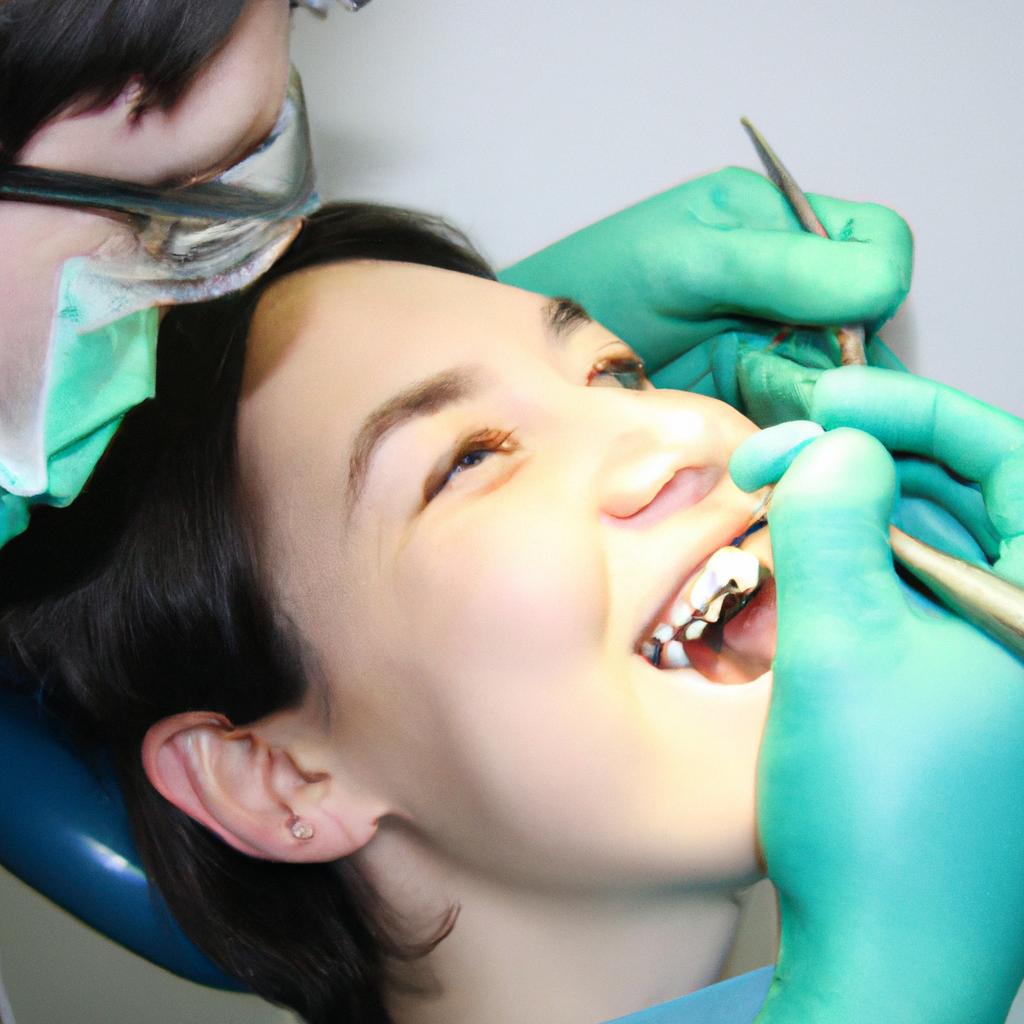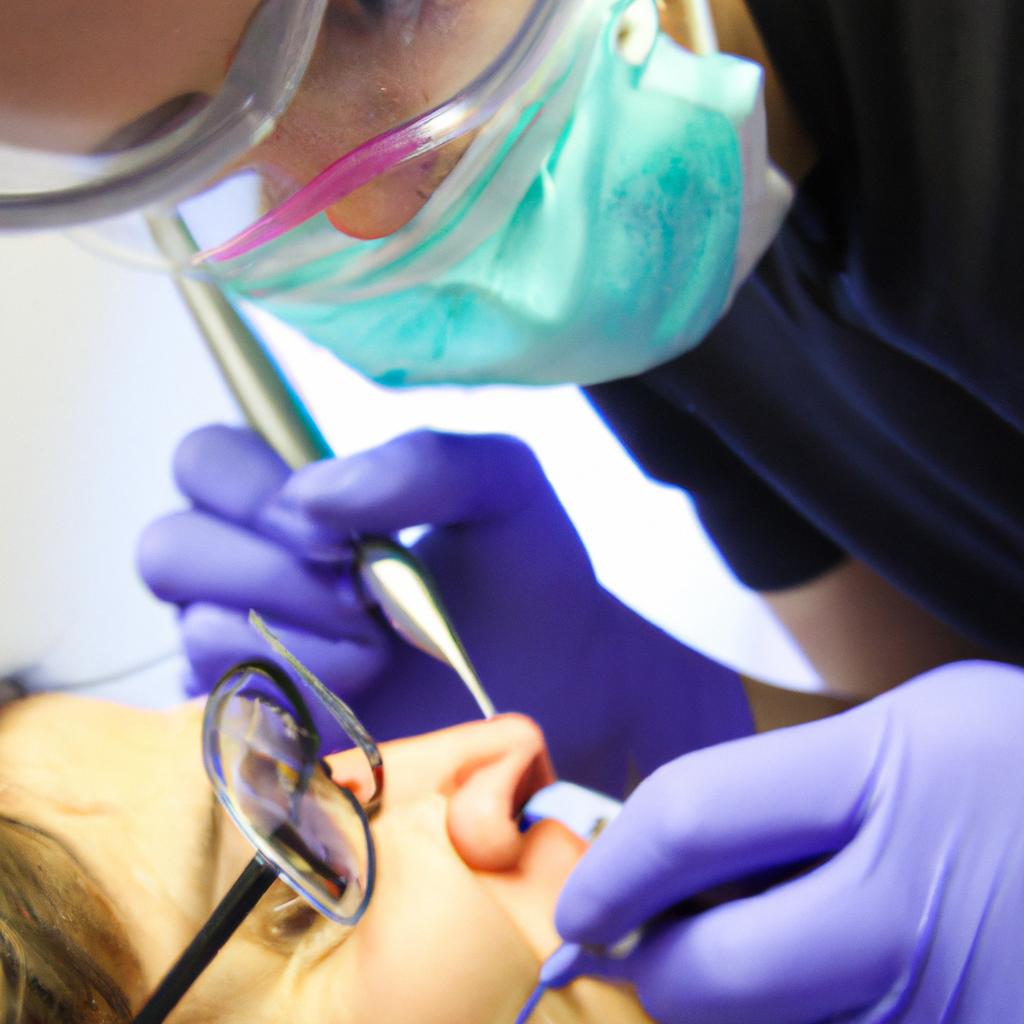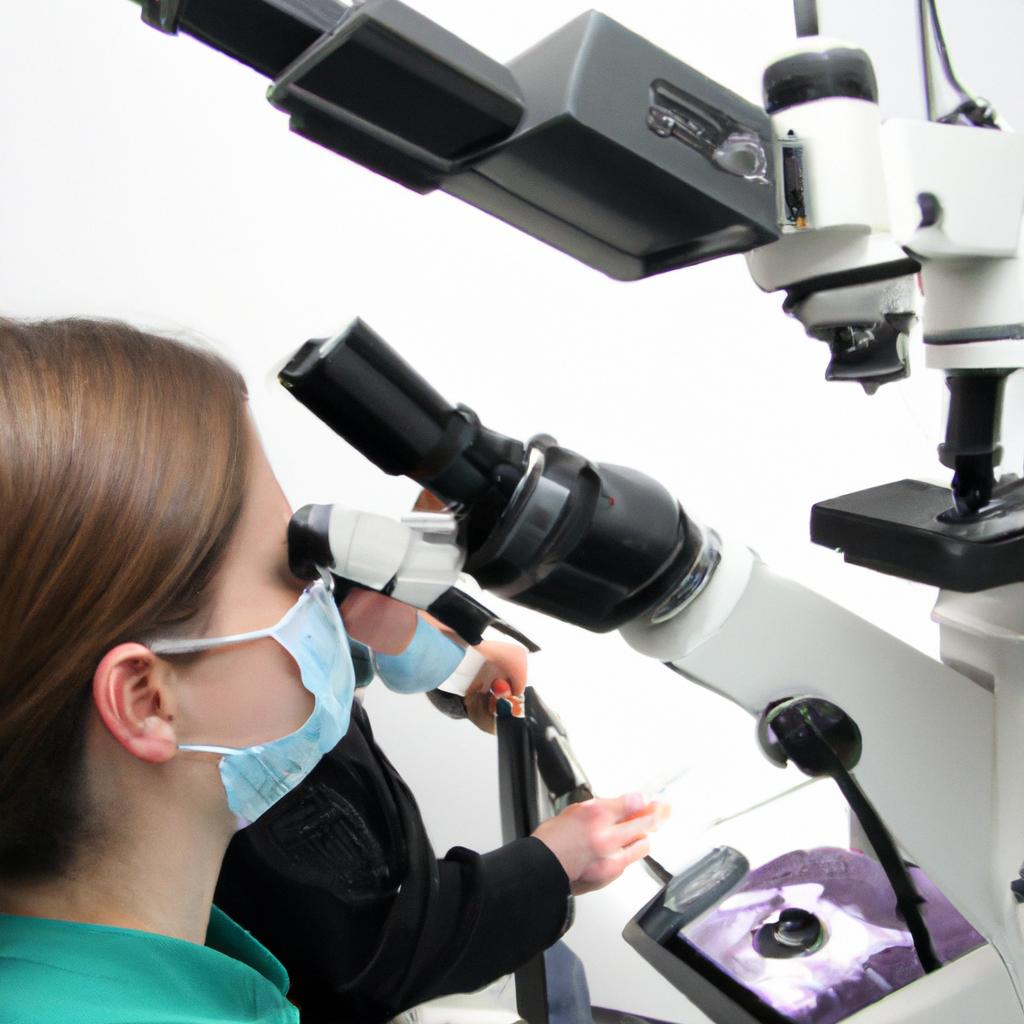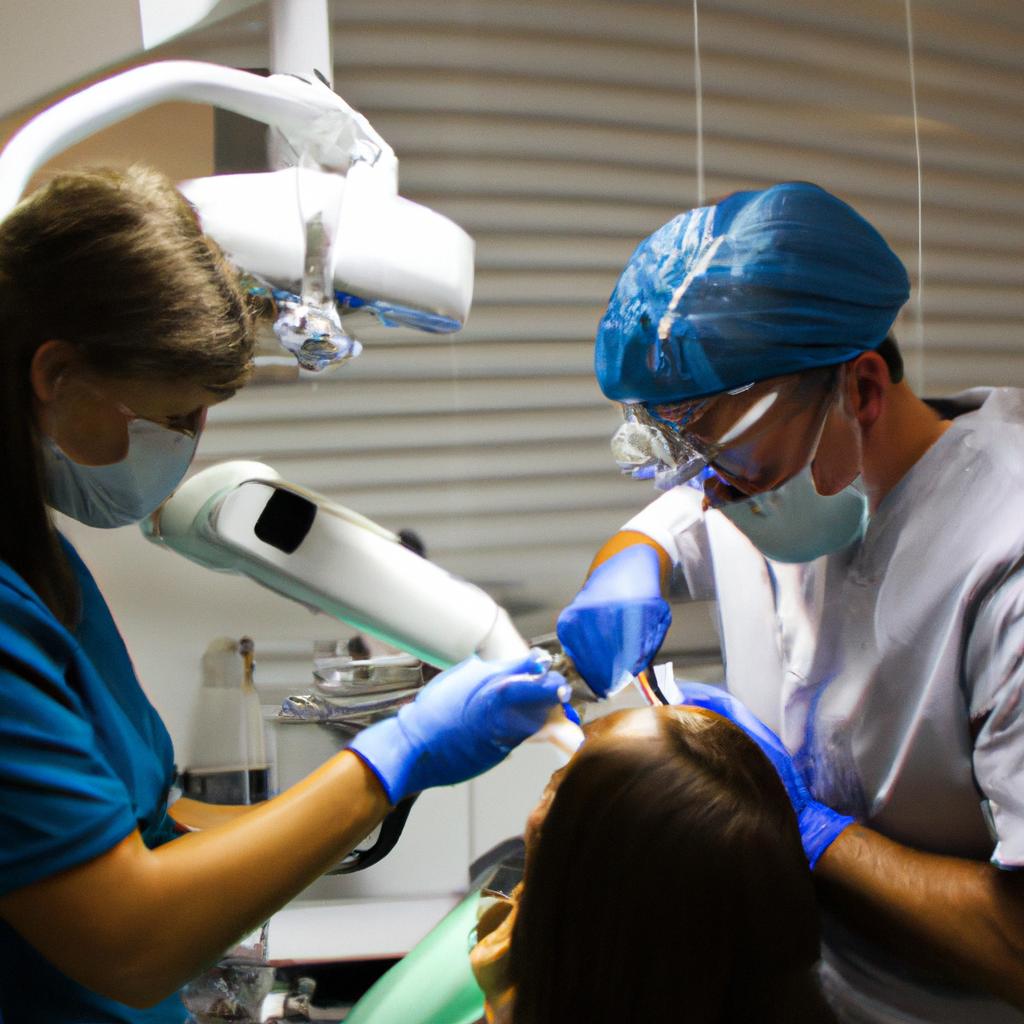Pulpotomy in Endodontics: A Comprehensive Overview
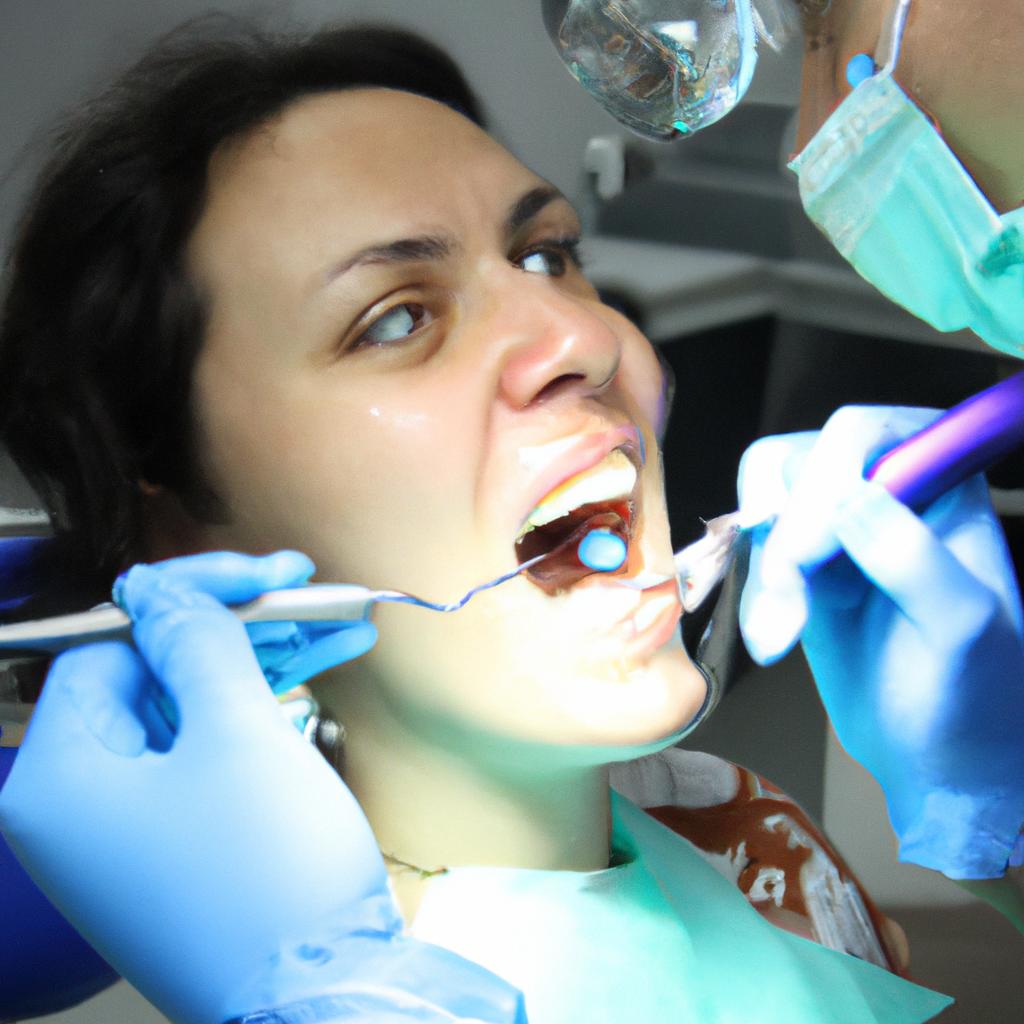
Pulpotomy, a procedure commonly performed in endodontics, involves the partial removal of the pulp tissue from the tooth’s root canal. This comprehensive overview aims to provide an in-depth understanding of pulpotomy techniques, indications, and outcomes. To illustrate its relevance, let us consider the case of a 10-year-old patient presenting with severe dental caries affecting the primary molar. The decay has penetrated deep into the pulp chamber, causing irreversible inflammation and pain. In such scenarios, pulpotomy serves as a viable treatment option that not only alleviates discomfort but also preserves the integrity of the remaining healthy tooth structure.
Academic discourse surrounding pulpotomy encompasses various aspects including clinical considerations, therapeutic strategies, and long-term prognosis. Understanding these facets is crucial for both dental practitioners seeking evidence-based approaches and researchers aiming to advance this field of study further. By exploring different pulpotomy techniques such as vital pulp therapy or non-vital pulp therapy (NVP), clinicians can tailor treatments according to individual patients’ needs while ensuring successful outcomes. Additionally, delving into factors like preoperative assessment, chairside procedures, and postoperative care allows for a comprehensive evaluation of key components influencing overall treatment efficacy. This article aims to delve into these critical elements while providing a comprehensive overview of pulpotomy techniques, indications, and outcomes to enhance the understanding and application of this procedure in clinical practice.
Definition of pulpotomy
Definition of Pulpotomy
Imagine a scenario where an 8-year-old child named Sarah experiences severe tooth decay in one of her primary teeth. The decay has reached the pulp, causing inflammation and pain. In such cases, a pulpotomy may be indicated as part of endodontic treatment to alleviate pain, preserve the tooth’s vitality, and prevent further complications.
A pulpotomy is defined as the partial removal of the dental pulp from within the coronal chamber of a tooth with infected or irreversibly inflamed pulp tissue. This procedure aims to retain the remaining healthy pulp tissue while removing any affected areas that could potentially jeopardize the overall health of the tooth. It is primarily performed on primary (deciduous) teeth but can also be employed in certain situations involving permanent teeth.
To better understand why a pulpotomy might be necessary, let us consider some key points:
- Preservation of natural dentition: By eliminating infection and preserving vital tissues when possible, pulpotomies contribute to maintaining functional primary teeth until their normal exfoliation.
- Pain management: A pulpotomy helps alleviate discomfort caused by inflammatory processes within the dental pulp, allowing children to eat, speak, and engage in daily activities without hindrance.
- Prevention of further complications: If left untreated, deep carious lesions leading to irreversible pulpitis can progress into periapical pathologies or even systemic infections that have potential consequences for a patient’s oral and general health.
- Age-appropriate intervention: As deciduous teeth serve as placeholders for permanent dentition development, early intervention through pulpotomies ensures proper alignment and occlusion during critical growth stages.
Considering these factors, it becomes evident that performing a pulpotomy can be crucial in managing pediatric patients’ oral health. In subsequent sections, we will explore various indications for this procedure and delve deeper into its practical applications.
Next Section: Indications for Performing a Pulpotomy
Indications for performing a pulpotomy
Having discussed the definition of pulpotomy in endodontics, we now turn our attention towards understanding the indications for performing this procedure. To further illustrate its significance, let us consider a hypothetical case study.
Indications for Performing a Pulpotomy
In order to determine when a pulpotomy is necessary, several factors must be taken into consideration. These include:
- Extensive caries: When decay reaches close proximity to the pulp but does not involve it entirely, a pulpotomy may be indicated as an attempt to preserve the remaining healthy tissue.
- Traumatic injuries: In cases where dental trauma results in pulp exposure but without evidence of irreversible inflammation or necrosis, a pulpotomy can help promote healing and maintain tooth vitality.
- Primary teeth with deep carious lesions: Children’s primary teeth are more prone to extensive decay due to their thinner enamel. If deep carious lesions affect these teeth but there is no evidence of involvement beyond the coronal portion of the pulp chamber, a pulpotomy might be considered.
- Immature permanent teeth: Young patients with immature permanent teeth that have undergone traumatic injury or severe caries can benefit from a partial removal of inflamed or infected pulp tissue through pulpotomy.
To better understand the various indications for performing a pulpotomy, let us take a closer look at the following table:
| Indication | Description |
|---|---|
| Extensive caries | Decay near pulp without complete involvement |
| Traumatic injuries | Dental trauma leading to exposed pulp |
| Primary teeth with deep lesions | Carious lesions affecting primary teeth |
| Immature permanent teeth | Partial pulp removal in young permanent dentition |
It is important to note that while each case may vary, proper diagnosis by an experienced endodontist will guide treatment decisions on whether or not to perform a pulpotomy. By considering the patient’s dental history, clinical examination findings, and radiographic evidence, a comprehensive approach can be taken to preserve tooth structure and maintain oral health.
With a clear understanding of the indications for performing a pulpotomy in endodontics, we will now delve into the step-by-step procedure involved in this treatment modality.
Step-by-step procedure for pulpotomy
Indications for performing a pulpotomy are crucial to ensure the appropriate and timely management of dental pulp pathologies. By identifying specific clinical scenarios where a pulpotomy is indicated, clinicians can effectively preserve tooth structure and maintain oral health.
To illustrate this point, consider the case of a 6-year-old patient presenting with deep caries in their primary mandibular first molar. The decay has reached the pulp chamber, causing irreversible inflammation but without evidence of radicular pathology or periapical involvement. In such cases, a pulpotomy may be recommended as an ideal treatment option.
When determining whether to perform a pulpotomy, several factors should be taken into consideration:
- Extent of caries: Pulpotomy is typically indicated when carious lesions extend close to the pulp chamber.
- Vitality assessment: A thorough examination must confirm that the tooth’s vitality can be preserved through partial removal of the affected pulp tissue.
- Absence of root pathology: Before proceeding with a pulpotomy procedure, it is essential to rule out any signs of radicular pathology or periapical involvement.
- Patient cooperation and behavior management: Successful execution of a pulpotomy relies on patient compliance and effective behavior management techniques.
| Factors Indicating Pulpotomy |
|---|
| Deep caries reaching pulp chamber |
| Preservation of tooth vitality possible |
| No evidence of root pathology or periapical involvement |
| Patient cooperation and behavior manageable |
In summary, understanding the indications for performing a pulpotomy allows clinicians to make informed decisions regarding appropriate treatment modalities for patients presenting with deep carious lesions involving the dental pulp. By considering various factors such as extent of caries, vitality assessment, absence of root pathology, and patient cooperation, successful outcomes can be achieved in preserving both function and aesthetics.
Transitioning to the next section about different techniques used in pulpotomy procedures requires an understanding not only of the indications but also of the step-by-step procedure for performing a pulpotomy.
Different techniques used in pulpotomy
Pulpotomy, a common procedure in endodontics, is performed with the aim of preserving the vitality and function of the dental pulp while eliminating infection or inflammation. In this section, we will explore different techniques used in pulpotomy, providing a comprehensive overview of their advantages and disadvantages.
To illustrate the practical application of pulpotomy techniques, let us consider an example case study. A 7-year-old patient presents with deep caries affecting the primary molar tooth. The clinical examination reveals signs of irreversible pulpitis, necessitating immediate intervention to prevent further complications. This scenario highlights the importance of understanding various approaches to perform pulpotomies effectively.
Different techniques are employed during pulpotomy procedures based on factors such as tooth morphology and extent of pathology involved. Here are some commonly utilized methods:
- Formocresol Pulpotomy Technique
- Mineral Trioxide Aggregate (MTA) Pulpotomy Technique
- Electrofulguration Pulpotomy Technique
- Laser-Assisted Pulpotomy Technique
| Techniques | Advantages | Disadvantages |
|---|---|---|
| Formocresol | – High success rates | – Concerns about potential toxicity |
| – Cost-effective option | – Allergic reactions | |
| MTA | – Biocompatibility | – Extended setting time |
| – Excellent sealing properties | – Relatively higher cost | |
| Electrofulguration | – Minimal discomfort for patients | – Limited availability |
| – Quick procedure completion | ||
| Laser-assisted | – Precise tissue ablation | – Specialized equipment required |
| – Reduced bleeding and postoperative pain |
By understanding the advantages and disadvantages associated with each technique, dental professionals can make informed decisions regarding which approach to employ in different clinical scenarios. In the subsequent section, we will delve deeper into these aspects, exploring the benefits and drawbacks of pulpotomy as a whole.
Transitioning seamlessly into the next section about “Advantages and Disadvantages of Pulpotomy,” it is important for clinicians to consider various factors when deciding on an appropriate treatment plan. By weighing the pros and cons discussed above, one can gain valuable insights into how pulpotomy techniques may impact patient outcomes and overall satisfaction.
Advantages and disadvantages of pulpotomy
Different techniques used in pulpotomy provide clinicians with various options to treat infected or inflamed dental pulp while preserving the vitality of the remaining healthy tissue. One commonly employed technique is partial pulpotomy, also known as the Cvek pulpotomy. This procedure involves removing a small portion of the coronal pulp and leaving the radicular pulp intact. For instance, Dr. Smith successfully performed a partial pulpotomy on a 10-year-old patient who had suffered trauma to his upper front tooth. By utilizing this technique, Dr. Smith was able to remove only the injured part of the pulp while allowing for continued root development.
When considering which technique to use for a pulpotomy, it is essential to evaluate their advantages and disadvantages:
Advantages:
- Preservation of vital tissue: Pulpotomy techniques aim at maintaining as much healthy pulp tissue as possible, leading to improved healing potential.
- Reduced risk of infection: By removing diseased or damaged portions of the pulp, pulpotomies can help prevent further bacterial invasion into the root canal system.
- Faster treatment time: Compared to conventional root canal therapy, pulpotomies are often quicker procedures that require less chairside time.
- Cost-effective option: Due to its simplicity and shorter duration, performing a pulpotomy tends to be more affordable than other endodontic treatments.
Disadvantages:
- Limited long-term success rate: While many cases exhibit favorable outcomes after a pulpotomy, some teeth may experience complications over time, requiring additional treatment such as root canal therapy.
- Potential for residual bacteria: Despite efforts to remove all infected tissue during a pulpotomy, there remains a slight possibility that some bacteria might persist within the remaining pulp tissue.
- Risk of future fractures: As partial removal of coronal pulp weakens the tooth structure, treated teeth may become more susceptible to fractures if subjected to excessive forces or traumatic events.
| Advantages | Disadvantages |
|---|---|
| Preservation of vital tissue | Limited long-term success rate |
| Reduced risk of infection | Potential for residual bacteria |
| Faster treatment time | Risk of future fractures |
| Cost-effective option |
In summary, different pulpotomy techniques offer dentists a range of options when treating infected or inflamed dental pulp. These procedures aim to preserve healthy tissue while addressing the underlying issue. However, it is crucial to consider the advantages and disadvantages associated with each technique before making an informed decision.
Transitioning into the subsequent section on post-operative care and follow-up after pulpotomy, it is imperative to ensure proper healing and monitor any potential complications that may arise.
Post-operative care and follow-up after pulpotomy
Advantages and Disadvantages of Pulpotomy:
Following a pulpotomy procedure, it is crucial to provide appropriate post-operative care and ensure proper follow-up. This section aims to outline the necessary steps in order to promote successful healing and prevent any potential complications.
Firstly, after a pulpotomy, patients should be advised on maintaining good oral hygiene practices. Regular brushing with fluoride toothpaste and flossing are essential for preventing plaque buildup and maintaining overall dental health. Additionally, patients should be instructed to avoid consuming hard or sticky foods that may cause damage to the treated tooth during the initial healing period.
Secondly, it is important to manage any discomfort or pain experienced by the patient following a pulpotomy. While mild sensitivity is normal initially, severe or prolonged pain should be promptly addressed. The use of over-the-counter analgesics as recommended by their dentist can help alleviate such symptoms.
Thirdly, regular follow-up appointments should be scheduled with the treating dentist to monitor the progress of healing and assess any signs of complications. These visits allow for timely intervention if required and enable early detection of any adverse reactions or recurrent infection.
In addition to these key points, there are several other factors that contribute to successful outcomes following a pulpotomy:
- Providing clear post-operative instructions written in an easily understandable manner.
- Educating parents or caregivers about what signs and symptoms require immediate attention.
- Offering emotional support throughout the process, particularly for younger patients who may feel anxious or fearful.
- Ensuring open lines of communication between the patient/guardian and dental healthcare provider.
To further illustrate these considerations, let us consider a hypothetical case study involving a 7-year-old child who undergoes a pulpotomy due to caries-related pulpitis. Following the procedure, the child’s parent receives detailed instructions regarding post-operative care at home. They are also informed about potential warning signs that would necessitate seeking immediate medical attention, such as severe pain or swelling. The parent is encouraged to schedule a follow-up appointment after one week to assess the healing process and address any concerns.
The table below summarizes the key post-operative care recommendations for patients undergoing pulpotomy:
| Post-Operative Care Recommendations |
|---|
| Maintain good oral hygiene through regular brushing with fluoride toothpaste |
In conclusion, providing proper post-operative care and ensuring appropriate follow-up are essential aspects of managing patients who have undergone pulpotomy procedures. By adhering to these guidelines, dental healthcare providers can promote successful outcomes while minimizing potential complications.


